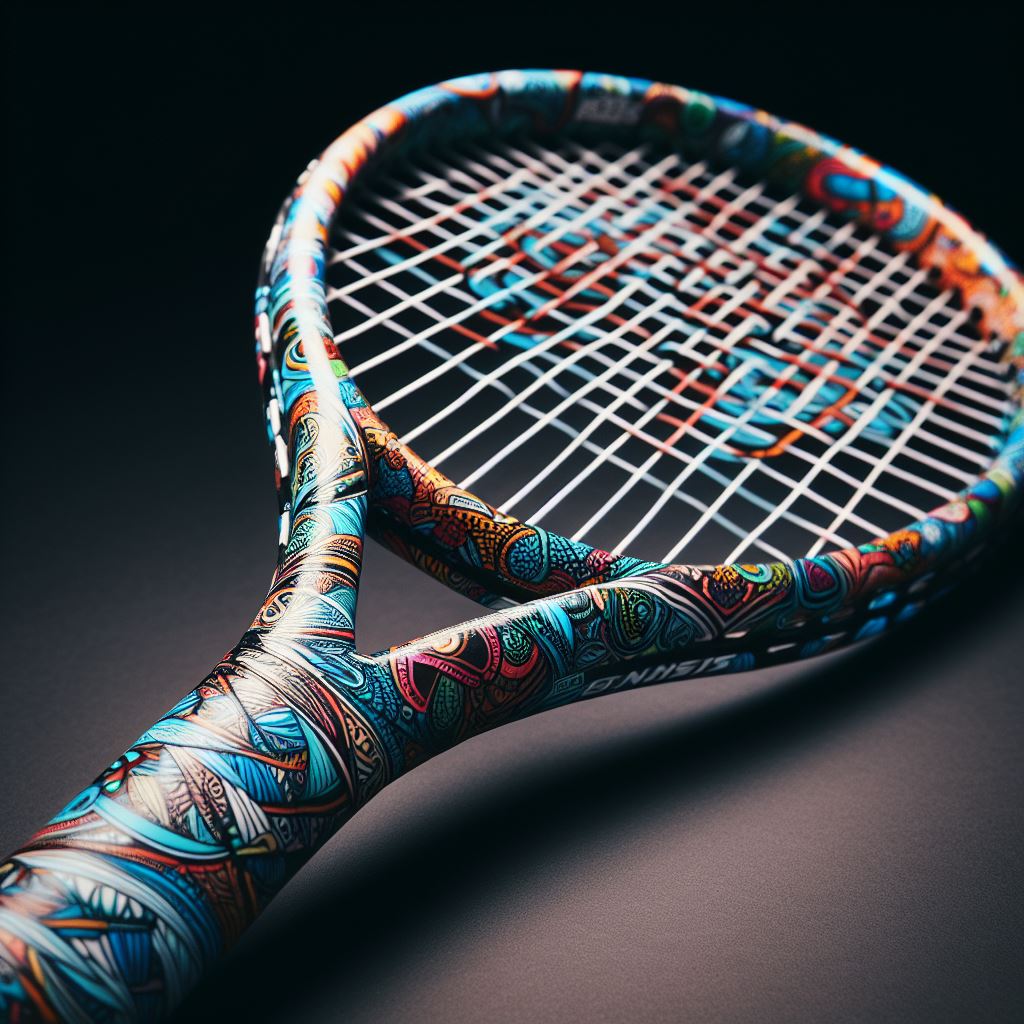Are you tired of settling for a one-size-fits-all approach to your racket? Yearning for a personalized touch that can elevate your game to new heights? Look no further.
In this article, we delve into the world of racket customization, where every aspect of your equipment can be tailored to your liking. From the perfect grip size to the ideal string tension, we explore the intricate details that can optimize your power, control, and overall performance.
Get ready to make your mark on the court like never before.
Key Takeaways
- Choosing the right grip size is crucial for control and power.
- String tension affects control and power in shots.
- The weight of the racket affects power, control, and maneuverability.
- Fine-tuning the balance point enhances maneuverability.
Grip Size: Find the Perfect Fit
When customizing your racket, it is essential to find the perfect fit for your grip size. Choosing the right grip size is crucial as it directly affects your ability to control the racket and generate power in your shots. The grip size refers to the circumference of the handle, and it can greatly impact your performance on the court.
To determine the ideal grip size, you need to consider the size of your hand. It is recommended to hold the racket in your dominant hand with a relaxed grip. If you can fit the index finger of your non-dominant hand between your fingertips and the base of your palm, then you have found the right grip size.
Finding the ideal grip size is crucial for several reasons. Firstly, a grip that is too small can cause the racket to twist in your hand during powerful shots, resulting in a loss of control. On the other hand, a grip that is too large can strain your hand and reduce maneuverability. It is important to strike the right balance to ensure optimum performance and comfort.
In addition to grip size, another factor to consider when customizing your racket is the string tension. The string tension determines the level of control and power in your shots. Higher string tension provides more control, but it may sacrifice power. Conversely, lower string tension offers more power but reduces control. Finding the ideal string tension depends on your playing style and personal preference.
String Tension: Optimize Power and Control
To optimize power and control in your shots, it is important to consider the string tension when customizing your racket. The string tension refers to the level of tightness or looseness of the strings on your racket. It plays a crucial role in determining the performance of your shots.
When it comes to string tension, there are two key factors to consider: the string material and the string pattern. Different string materials offer varying levels of power and control. For example, polyester strings are known for providing excellent control, while multifilament strings offer more power. Experimenting with different string materials can help you find the right balance of power and control that suits your playing style.
In addition to the string material, the string pattern also affects the performance of your shots. The string pattern refers to the arrangement of the strings on your racket. A denser string pattern provides more control, while a more open string pattern offers increased power. By experimenting with different string patterns, you can find the optimal setup that enhances both power and control in your shots.
Racket Weight: Customize Your Swing
The weight of your racket is a crucial factor to consider when customizing your swing and enhancing your performance on the court. The right racket weight can provide you with the necessary power, control, and maneuverability to excel in your game. When it comes to racket weight, there are various options available, each with its own advantages and disadvantages.
Finding the right racket length is essential in order to achieve the proper reach and balance. A longer racket provides increased reach, allowing you to cover more ground and hit shots with greater power. However, a longer racket can also be more challenging to maneuver, especially for players with shorter arms or those who prefer a faster swing speed. On the other hand, a shorter racket offers enhanced maneuverability, making it easier to control shots and react quickly on the court. However, it may sacrifice some reach and power.
In addition to racket length, the choice of racket material is another important consideration. Different materials offer varying levels of stiffness, which can affect the power and control of your shots. Graphite rackets are popular for their lightweight and stiffness, providing excellent power and control. Aluminum rackets, on the other hand, are more durable but may lack the same level of power.
Consider the following table for a breakdown of different racket weights, lengths, and materials:
| Racket Weight | Racket Length | Racket Material |
|---|---|---|
| Light | Short | Graphite |
| Medium | Standard | Aluminum |
| Heavy | Long | Carbon fiber |
Balance Point: Fine-Tune Your Maneuverability
Achieving optimal maneuverability on the court can be accomplished by fine-tuning the balance point of your customized racket. The balance point refers to the distribution of weight along the racket’s length, and it plays a crucial role in determining the racket’s maneuverability vs stability.
To enhance maneuverability, you can shift the balance point towards the handle. This makes the racket feel lighter and easier to swing, allowing for quick and precise movements. On the other hand, if you prefer more stability and power in your shots, you can adjust the balance point towards the head of the racket. This provides a solid and stable feel, ideal for players who rely on powerful strokes.
When customizing your racket’s balance point, it’s important to consider your playing style and personal preferences. Experiment with different balance points to find the one that suits you best. Additionally, keep in mind that altering the balance point may affect other aspects of your game, such as the feel and control of the racket.
By fine-tuning the balance point, you can tailor your racket to enhance your maneuverability and optimize your performance on the court.
Now, let’s explore another aspect of racket customization: dampening systems, which improve comfort and reduce vibrations.
Dampening Systems: Improve Comfort and Reduce Vibrations
One key aspect of customizing your racket is incorporating a dampening system to improve comfort and reduce vibrations. When playing tennis or any racket sport, vibrations can cause discomfort and affect your performance.
Dampening systems, such as gel-filled handles and vibration dampeners, can help minimize these vibrations and provide a more comfortable playing experience.
A gel-filled handle is a popular option for reducing vibrations. The gel material absorbs the shock and vibrations generated during ball impact, effectively reducing the impact felt by the player’s hand. This not only improves comfort but also helps prevent injuries, such as tennis elbow.
Vibration dampeners, on the other hand, are small devices that can be inserted into the strings of the racket. These dampeners work by altering the frequency and amplitude of the vibrations, resulting in a softer feel upon ball contact. They can also help reduce the ‘ping’ sound that some players find distracting.
When choosing a dampening system, it’s important to consider your personal preferences and playing style. Some players may prefer a softer, more cushioned feel, while others may prefer a firmer response. Experimenting with different dampening options can help you find the right balance of comfort and performance for your game.
Frequently Asked Questions
How Do I Choose the Right Grip Size for My Racket?
Choosing the right grip size for a racket is crucial for optimal performance and comfort. To measure your grip size accurately, measure the distance between your palm’s middle crease and the tip of your ring finger.
What Is the Optimal String Tension for Power and Control?
The optimal string tension for power and control in racket customization depends on various factors such as playing style, racket head size, and string type. Achieving the perfect balance requires careful consideration and experimentation.
How Can I Customize the Weight of My Racket to Suit My Swing?
To customize the weight of your racket to suit your swing, you can make adjustments by customizing the racket grip and adjusting the racket balance. These modifications allow for a personalized and optimized playing experience.
What Is the Balance Point of a Racket and How Does It Affect Maneuverability?
The balance point of a racket refers to its distribution of weight. It plays a crucial role in racket customization as it affects maneuverability. Techniques such as adjusting weight and grip size can be used to improve racket maneuverability.
What Are Dampening Systems and How Do They Improve Comfort and Reduce Vibrations?
Dampening systems in rackets improve comfort and reduce vibrations, enhancing the player’s experience. They come in various types and offer benefits like shock absorption, but can also have drawbacks such as added weight and decreased maneuverability.
Conclusion
In conclusion, by customizing your racket, you can optimize your performance on the tennis court. From finding the perfect grip size to fine-tuning the balance point, every aspect of your racket can be tailored to your specific needs.
By adjusting string tension and incorporating dampening systems, you can enhance power, control, comfort, and reduce vibrations.
So take charge of your game, make your racket truly yours, and unleash your full potential on the court.








No Comment! Be the first one.